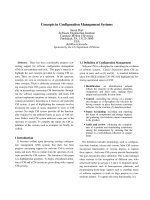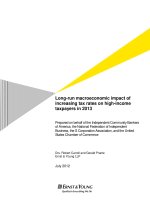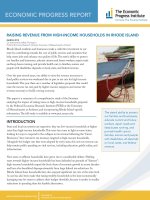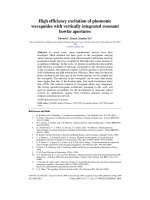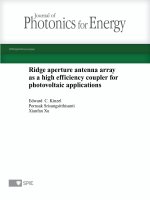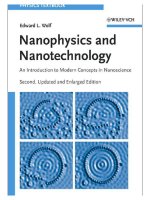PV BASICS PART 2(SOLAR CELLS - HIGH EFFICIENCY CONCEPTS IN SPV
Bạn đang xem bản rút gọn của tài liệu. Xem và tải ngay bản đầy đủ của tài liệu tại đây (3.23 MB, 59 trang )
PV BASICS PART 2
(SOLAR CELLS - HIGH EFFICIENCY CONCEPTS IN SPV)
Dr. O.S. SASTRY
DIRECTOR, PV TESTING
SOLAR ENERGY CENTRE
PH. 0124-2579213; Fax: 0124-2579207e.mail:
LECTURE FORMAT
•
•
•
•
•
Basics of Semiconductors
Solar Cell Device (P-N Junction)
Fabrication Technologies of Silicon Solar Cell
Concepts of High Efficiency Silicon Solar Cells
Third Generation Concepts
BASICS OF SEMICONDUCTORS
MAJOR REQUIREMENTS FOR CELL MATERIAL
Technical:
· HIGH ABSORPTION COEFFICIENT
.
LONG DIFFUSION LENGTH;
.
SLOW RECOMBINAION
.
BAND GAP
GENERAL:
· LOW COST MATERIALS WITH TAILORABLE PROPERTIES
· ABUNDANT MATERIAL
· CONVENIENCE OF SHAPES AND SIZES
· SIMPLE AND INEXPENSIVE INTEGRATED PROCESSING
FABRICATION & ECONOMICS RELATED:
· MINIMUM MATERIAL / WATT
· MINIMUM ENERGY INPUT/ OUTPUT WATT
· ENERGY PAY BACK PERIOD < 2 YEARS
COST PAY BACK PERIOD< 5 YEARS
· LONG LIFE (> 20 Years)
· COST (< $1/Watt)
TYPICAL PARAMETERS
Thin Films Eg(eV)
α (cm-1) Life Time Recombination Diffusion
(S)
(cm/s) Velocity Length (µm)
C-Si
1.1
102-104
> 10-4
> 103
>10
A-Si:H
1.1-2.0
> 104
< 10-6
> 106
< 0.1
GaAs
1.4
> 104
> 10-6
> 105
~ 0.2
CdTe
1.45
> 104
~ 10-5
> 104
~ 0.4
Cu-In-Se
1.1
> 104
~ 10-5
> 104
~ 0.2
Cu-In-S
1.6
> 104
~ 10-5
> 104
~ 0.2
TRANSPORT EQUATIONS
· Generation Rate G(x)= [ E∞ g (f) [1-R(E)] α(E) exp I-d(E)x]dE
· I(V)=IS exp(eV
nkT
- 1) – IL
V V-IRS & I I - V-IRS
R
sh
POSSIBLE TFSC MATERIALS
Single Elements:
Si ( epi, mc, nc, mixed)
Carbon (nanotubes, DLC)
Binary alloys / Compounds:
Cu2S, Cu2O Cu-C, CdTe, CdSe,
GaP, GaAs, InP,ZnP , a-Si : H, Dye coated TiO2
Ternary Alloys / Compounds:
Cu-In-S, Cu-In-Se. CdZnSe , CdMnTe, Bi-Sb-S,
Cu-Bi-s, Cu-Al-Te, Cu-Ga-Se, Ag-In-S, Pb-Ca-S,
Ag-Ga-S, Ga-In-P, Ga-In-Sb ,and so on.
Organic Materials:
Semiconducting Organics / Polymers and Dyes
SOLAR CELL DEVICE (p-n JUNCTION)
• A solar cell is a p-n junction semiconductor device.
• When p and n type semiconductors are brought together
the Fermi levels try to come to the same level. This results in
band bending to maintain the charge equilibrium
• When SUN radiation incidents on such junction, current is
generated due to creation of electron – hole pairs, the
electric field/ voltage (emf) developed due to band bending
drives the light generated charge carriers down the electric
field gradient, pushes in to the load. In this way both voltage
and current, hence power are generated.
Understanding Operation of Solar Cell
Reflection
Absorption
Generation
Separation
Collection
Section View of a Solar Cell
SOLAR CELL
•
o
o
o
o
•
Solar Cell operations depend on :
Absorption of light to create electron-hole pairs (carriers)
Diffusion of carriers
Separation of electrons and holes
Collection of carriers
A Solar cell is a light driven battery with an open current
voltage (Voc), short circuit current (Isc), maximum power point
current and voltage (In, Vm), and a series and a parallel
resistance (Rs, Rsh).
• Solar Cell Efficiency
η – output = Im Vm = I siVIL FT
input
Σ nhv Σ nhv
depends on quantum efficiency of creation of carriers,
effectiveness of separation of carriers before recombination
and collection of the separated carriers.
• Highest Theoretical
Homo-junction ~ 30%
Hetero-junction ~ 42%
36 Tandem Multi-gap Junctions 75%
Equivalent Circuit of Solar cell
Industrial Silicon Solar Cells
(for 1 sun)
(Cell size 125 mm x 125 mm square/pseudo square)
Ag contacts
SiNx:H ARC
n+emitter
p-silicon base
ρ = 0.5-3 Ώ cm, CZ-Si, Area= 78-140cm2: η = 12-15%(1sun)
FABRICATION TECHNOLOGIES
OF
SILICON SOLAR CELL
PV Value Chain – c-Si and Thin Films Modules
Key materials required for module
Design, tools & equipments
Glass
Silver paste
Wire
SiC
Tedler
Aluminium
EVA/PVB
Connection Box
Crucibles
Aluminum (frames)
PEG
Process gas
SOLAR CELL (SILICON) FABRICATION TECHNOLOGY
QUARTZ (SiO2)SAND
METALLAZRY GRADE -Si
SOLAR GRADE -Si
SINGLE CRYSTAL INGOT
WAFERING
DOPING (p-n JUNCTION FORMATION)
TEXTURIZATION AND AR COATING
BACK SURFACE METALLIZATION
FRONT SURFACE GRIDDING
TESTING
STRINGING
MODULE LAMINATION
MINIMUM MATERIAL LOSS DURING PROCESSING
ENERGY CONSUMPTION
COST PAY BACK PERIOD
: About 20 TO 30%
: ~ 3 kWh/Wp
: < 5 YEARS

